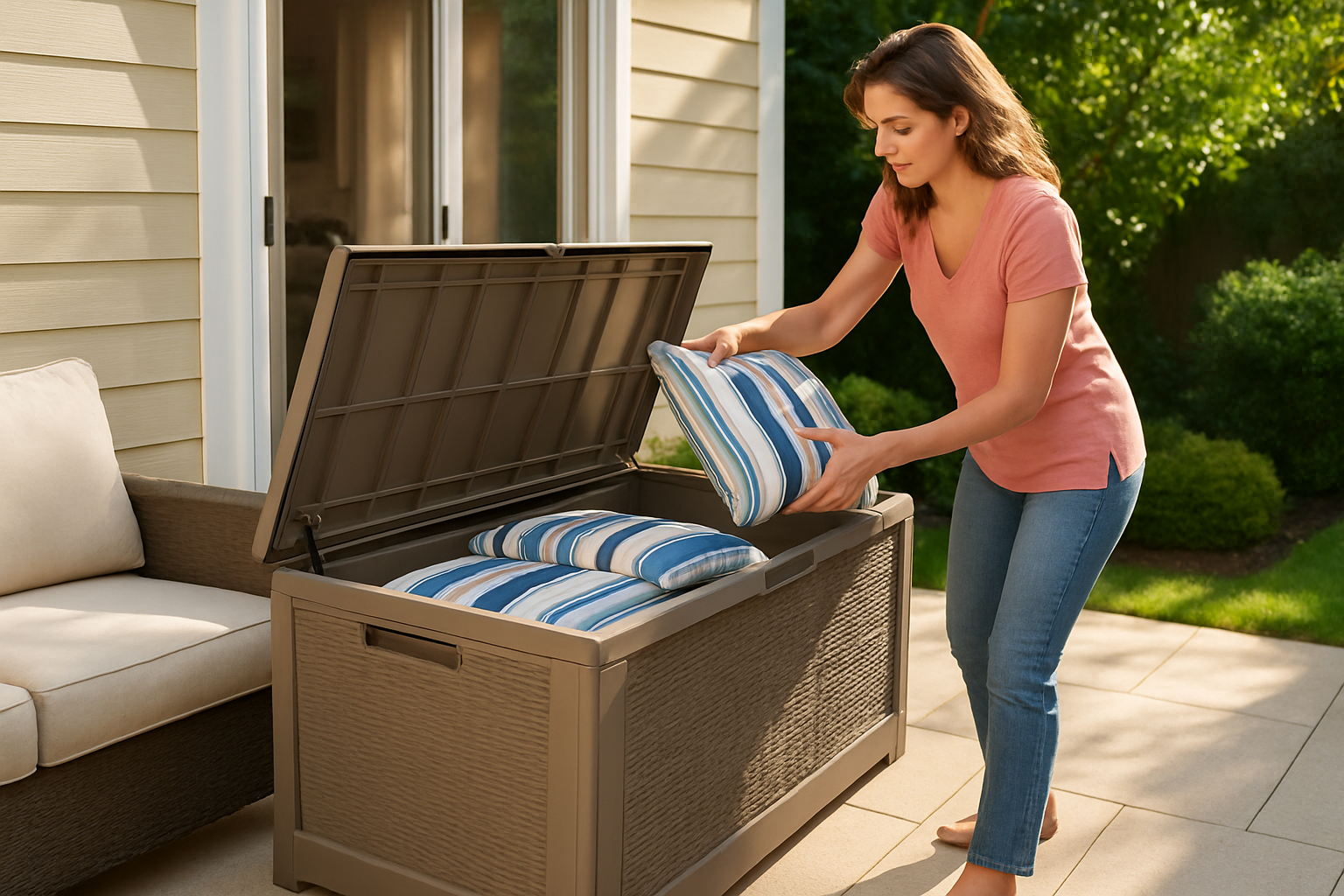Table of Contents
Memorial Day weekend three years ago, I eagerly dragged our patio furniture out of winter storage, ready to finally enjoy some outdoor living after months of being cooped up inside. I pulled the covers off our cushions and nearly cried. What had been beautiful, expensive outdoor cushions last fall were now disgusting specimens of what happens when fabric meets moisture and time.
Black spots covered every surface – not just a little mildew, but full-scale fungal takeover that looked like something from a horror movie. The smell was indescribable – imagine wet dog mixed with basement mold and a hint of despair. These cushions had cost me over $300 the previous spring, and now they looked like toxic waste that belonged in a hazmat bag.
My husband cheerfully suggested we just “hose them off and see what happens,” which is exactly the kind of optimism that makes me question his grip on reality. You don’t hose off what looks like a science experiment and expect good results.
Standing there with $300 worth of ruined cushions, I realized my complete lack of proper outdoor cushion storage had just cost me serious money. Worse, it was going to happen again next year unless I figured out how to protect our outdoor investments from the elements.
The Expensive Outdoor Cushion Disaster Cycle
Here’s what nobody warns you about outdoor furniture cushions: they’re basically expensive sponges designed to absorb every drop of moisture from rain, dew, and humidity, then cultivate impressive mold collections while you’re not looking. Even “weather-resistant” cushions aren’t actually waterproof – they’re just slower to develop their fungal ecosystems.
The cycle is predictable and expensive. You buy beautiful cushions that make your patio look like a magazine spread. They survive the first few months fine, maybe even the first season if you’re lucky. But then moisture finds its way in – through seams, around zippers, or just through the fabric itself during extended rainy periods.
Once mold gets established, it’s basically game over. You can try cleaning products, pressure washing, even bleach solutions, but those black spots are permanent residents now. The fabric integrity is compromised, the smell never fully goes away, and you’re shopping for replacement cushions again.
The real kick in the teeth is that good outdoor cushions cost a fortune. You’re looking at $50-100 per cushion for anything decent, and a typical patio set needs four to eight cushions. Do that math, and you’re talking about hundreds of dollars that you’ll be spending repeatedly if you don’t solve the outdoor cushion storage problem.
The Simple Outdoor Cushion Storage System That Saves Hundreds
After my Memorial Day cushion catastrophe, I was determined to never repeat that expensive mistake. The solution that saved my sanity (and my budget) was surprisingly straightforward: proper outdoor cushion storage using basic containers that keep moisture completely away from the fabric.
This approach works because it eliminates the root cause of cushion destruction – moisture exposure. Instead of hoping cushions can survive weather they weren’t designed to handle, you create a completely controlled storage environment that preserves them perfectly between uses.
Setting Up Your Outdoor Cushion Storage System
Step 1: Choose Your Storage Method
For the most reliable outdoor cushion storage, invest in a waterproof deck box – those large plastic storage containers specifically designed for outdoor use. A decent-sized deck box that holds 4-6 standard cushions costs around $80-120, which sounds expensive until you realize it prevents having to replace $300+ worth of cushions every few years.
The basic Rubbermaid or Sterilite deck boxes work perfectly for outdoor cushion storage. Look for ones with tight-fitting lids and good reviews for water resistance. The 120+ gallon capacity handles most standard patio cushion sets comfortably.
For budget-conscious outdoor cushion storage, heavy-duty contractor trash bags can work as temporary protection. Use the thick 3-mil bags that cost about $15 for a box of 25. Double-bag each cushion and squeeze out all air before sealing tightly. This method works for short-term storage but isn’t ideal for full season protection.
Step 2: Prepare Cushions for Storage
Before storing cushions in your outdoor cushion storage system, make sure they’re completely dry. Even slightly damp cushions will develop mold in storage, defeating the entire purpose of protecting them from moisture.
If cushions have gotten wet, let them air dry thoroughly in sunny, windy conditions – both sides completely dry to the touch. This might take a full day depending on thickness and weather conditions. Don’t rush this step or your outdoor cushion storage efforts will backfire spectacularly.
For removable covers, unzip them and check that the foam inserts are dry too. Foam holds moisture longer than you’d expect, and trapped dampness inside covers creates perfect mold-growing conditions even in storage.
Step 3: Pack Smart for Maximum Protection
When using a deck box for outdoor cushion storage, don’t just throw cushions in randomly. Stack them neatly with the largest ones on the bottom and smaller ones on top. This prevents crushing and makes retrieval easier when you want to use your patio again.
Place a moisture absorber packet in your storage container – those silica gel packets or basic moisture absorber products from the hardware store cost around $5-8 and provide extra insurance against humidity in your outdoor cushion storage system.
If using trash bags for outdoor cushion storage, fold cushions as little as possible to prevent permanent creases. Roll the bag opening tightly and secure with strong tape or zip ties to create an airtight seal that keeps moisture completely out.
Step 4: Strategic Storage Placement
Position your deck box in a shaded area if possible – direct sunlight can make plastic storage containers incredibly hot, which isn’t great for cushion fabric over time. Under a covered porch or patio area works perfectly for outdoor cushion storage.
Make sure your storage location has good drainage so the container isn’t sitting in standing water during heavy rains. Even waterproof containers can develop leaks if they’re constantly sitting in puddles.
If storing cushions indoors during off-season, choose a dry area like a garage, basement, or spare room. Avoid damp basements or unventilated storage areas where humidity can still cause problems with your outdoor cushion storage efforts.
Essential Supplies for Cushion Protection Success
Storage Container Options
Basic deck boxes from home improvement stores work great for outdoor cushion storage – expect to pay $60-150 depending on size and features. The Lifetime brand boxes get good reviews for durability and weather resistance at reasonable prices.
For smaller spaces, consider vacuum storage bags designed for bedding and clothing. These compress cushions significantly and cost around $10-15 for a set. They work well for seasonal outdoor cushion storage when space is limited, though they’re not ideal for frequent access.
Large plastic storage tubs with tight-fitting lids can substitute for deck boxes if you already have them. The key is ensuring a good seal to keep moisture out of your outdoor cushion storage system.
Protection Accessories
Moisture absorber products specifically designed for storage areas cost around $5-10 and provide extra protection in your outdoor cushion storage containers. The rechargeable ones save money long-term compared to disposable packets.
Furniture covers can provide temporary protection if you need to leave cushions out occasionally. Basic waterproof covers cost $15-30 and work for short-term protection, though they’re not a substitute for proper outdoor cushion storage.
Cedar blocks or lavender sachets can prevent musty odors during long-term storage. These natural options cost around $8-12 and keep your cushions smelling fresh when you bring them out of outdoor cushion storage.
Why This Storage Method Actually Works
Unlike hoping that “weather-resistant” fabrics can handle unlimited moisture exposure, this outdoor cushion storage approach eliminates the problem entirely. No moisture contact means no mold, no mildew, no fabric degradation, and no expensive replacements.
The controlled environment prevents UV damage too. Even fade-resistant fabrics eventually lose color when exposed to constant sunlight. Proper outdoor cushion storage keeps colors vibrant season after season.
Most importantly, this system works with real life instead of requiring perfect weather awareness. You don’t have to rush outside every time it starts raining or remember to cover cushions every evening. Just store them properly when the season ends, and they’ll be perfect when you want them again.
Long-Term Benefits Beyond Cushion Protection
Proper outdoor cushion storage dramatically extends cushion lifespan from 2-3 years to 8-10 years or more. When you do the math on replacement costs, good storage pays for itself many times over during the life of one cushion set.
Your patio setup becomes much more weather-flexible. Instead of constantly worrying about sudden rain or overnight dew, you can leave furniture out without stress because the expensive parts are safely stored.
The storage containers double as extra outdoor storage for other seasonal items. Pool supplies, gardening tools, outdoor games – deck boxes earn their keep beyond just outdoor cushion storage by providing general outdoor organization.
Seasonal Timing and Best Practices
Start your outdoor cushion storage routine at the first sign of consistently wet weather or when you know you won’t be using the patio regularly. Don’t wait until the end of the season when damage might already be starting.
In mild climates, you might store cushions temporarily during rainy periods and bring them out again when dry weather returns. This flexibility is one of the major advantages of having a good outdoor cushion storage system in place.
For winter storage, add extra moisture protection and check periodically if possible. Long-term outdoor cushion storage benefits from occasional air circulation, especially in humid climates.
Troubleshooting Common Storage Issues
If cushions develop musty smells even with proper storage, they weren’t completely dry when stored. Air them out thoroughly and ensure complete drying before returning them to your outdoor cushion storage system.
Permanent creases from folding can be minimized by storing cushions as flat as possible. If space requires folding, rotate the fold lines periodically during long-term outdoor cushion storage.
For cushions that seem prone to mold despite careful storage, consider replacing them with quick-dry foam versions designed for marine use. These cost more initially but are virtually mold-proof with proper outdoor cushion storage.
This outdoor cushion storage approach costs $60-120 to set up initially but saves hundreds of dollars in cushion replacements over the years. More importantly, it eliminates the frustration of discovering expensive outdoor furniture accessories have been destroyed by preventable moisture damage.
Give this system one season to prove its value, and you’ll never go back to hoping cushions can survive weather exposure on their own. Your patio investment will last for years instead of needing constant expensive replacements, and you’ll actually enjoy using your outdoor space instead of stressing about protecting it.
Because life’s too short to keep buying replacement patio cushions every few years when moisture turns your expensive outdoor investments into moldy science experiments, when proper storage can make those same cushions last a decade while keeping your patio looking magazine-perfect instead of like a furniture graveyard.

